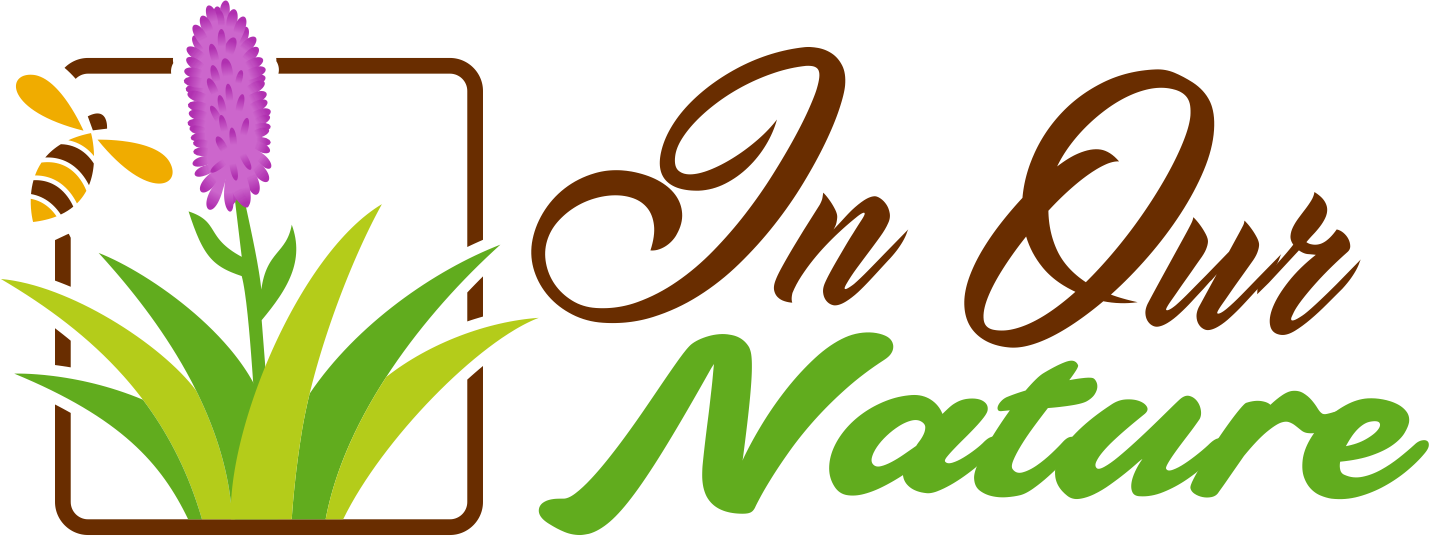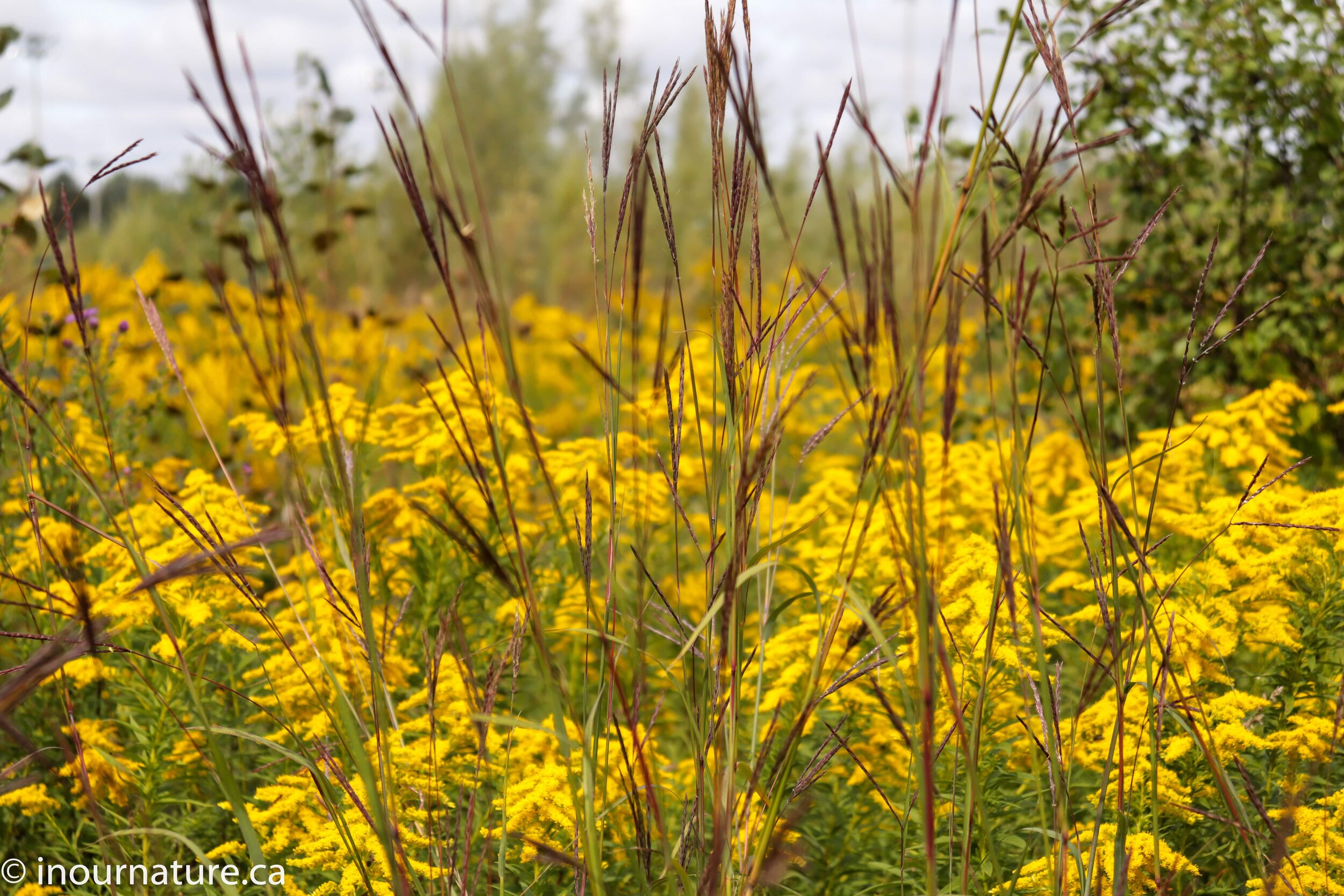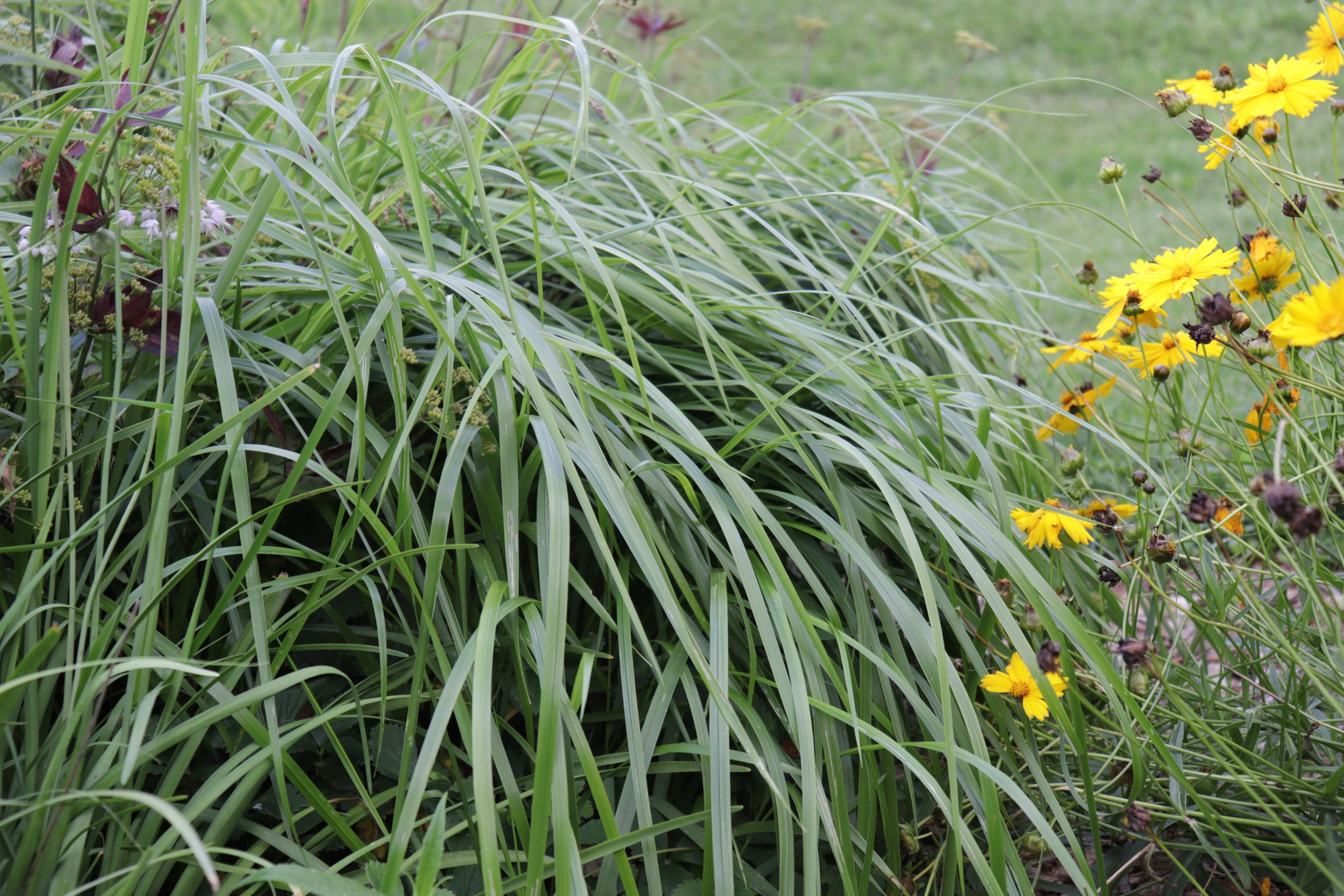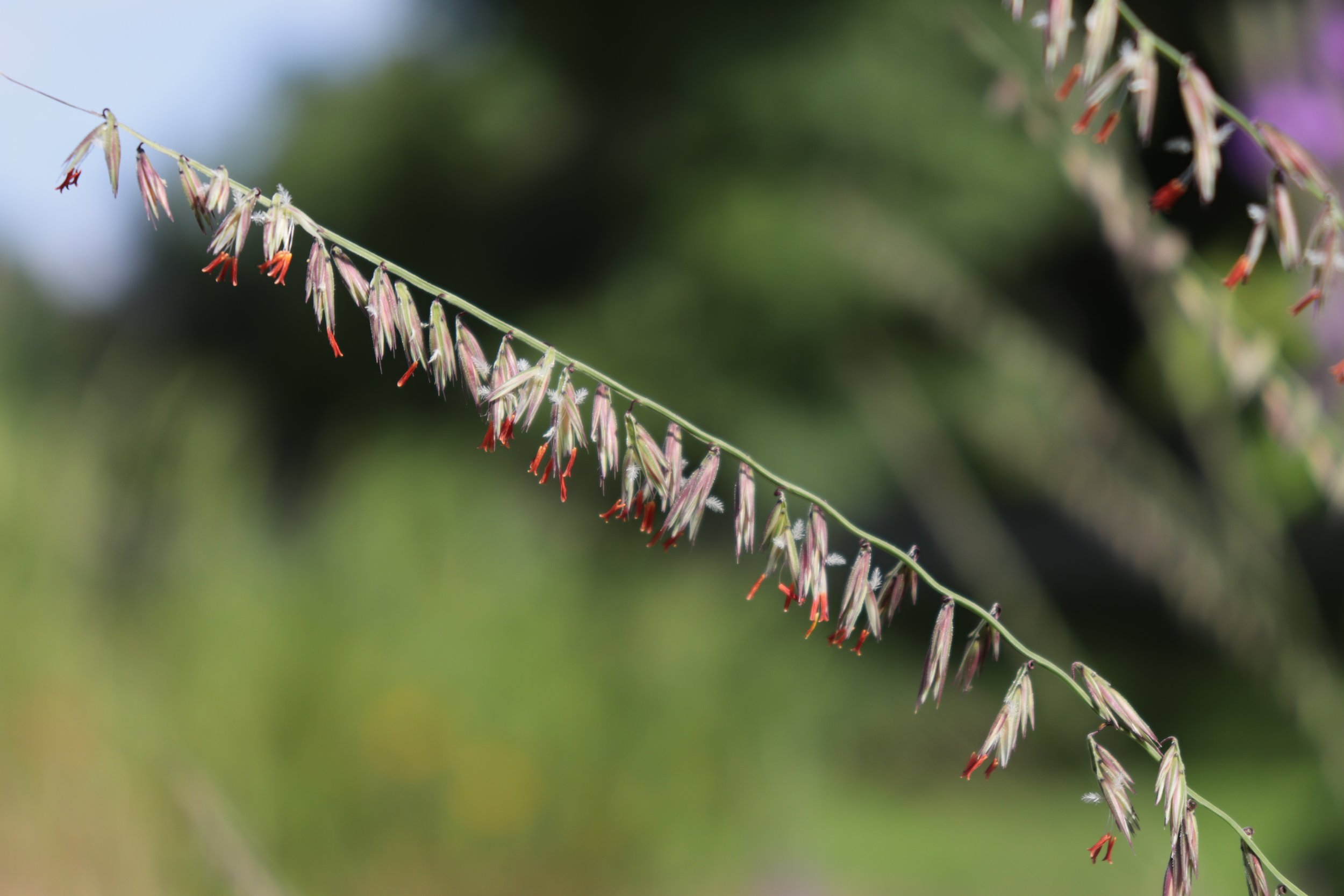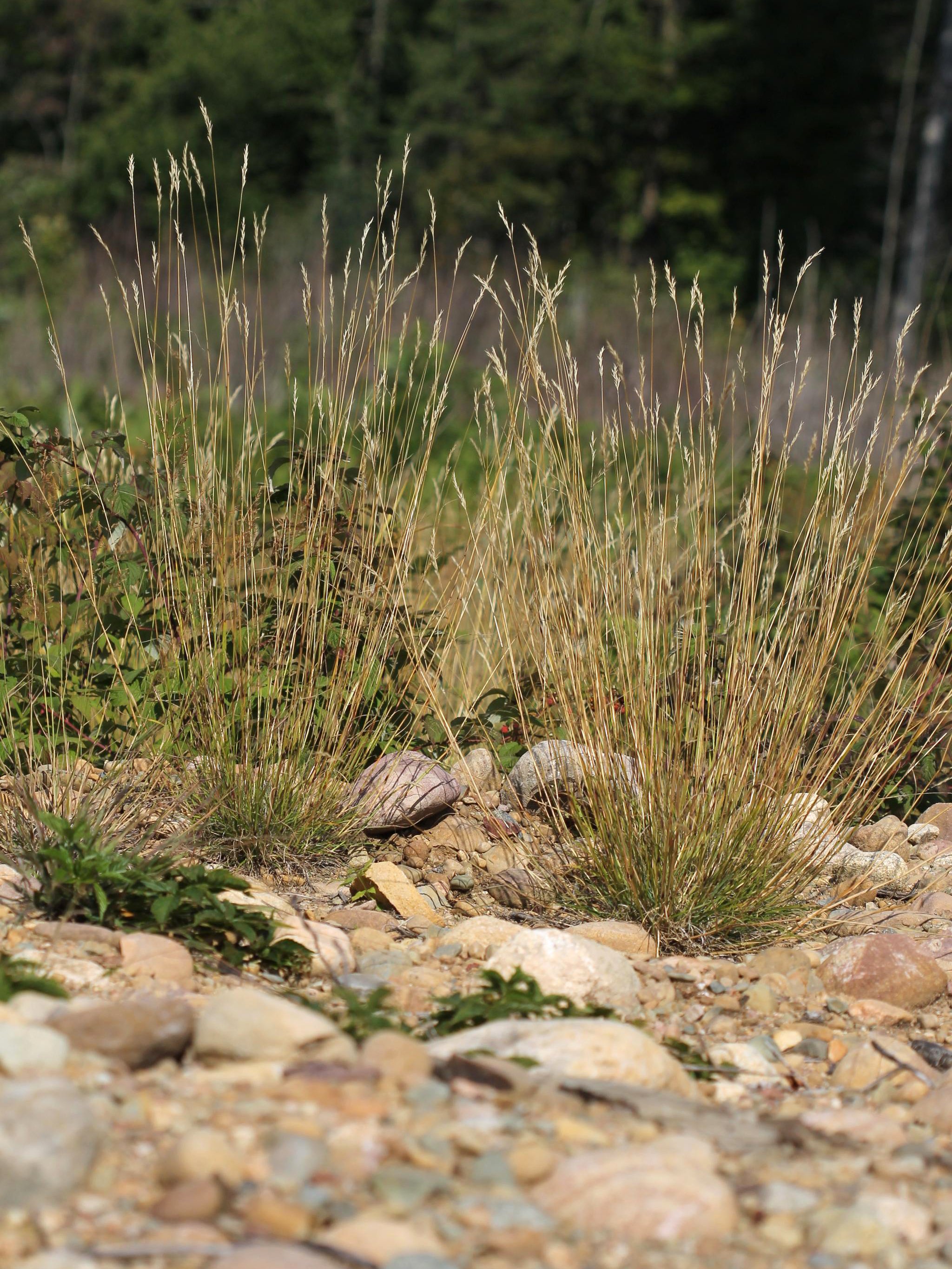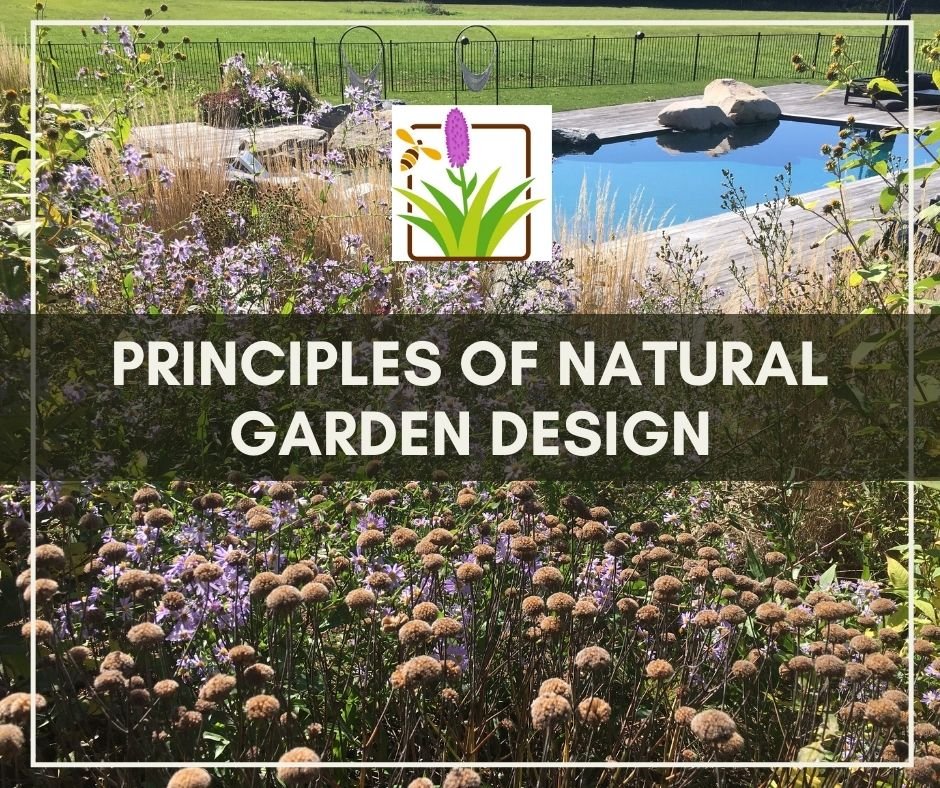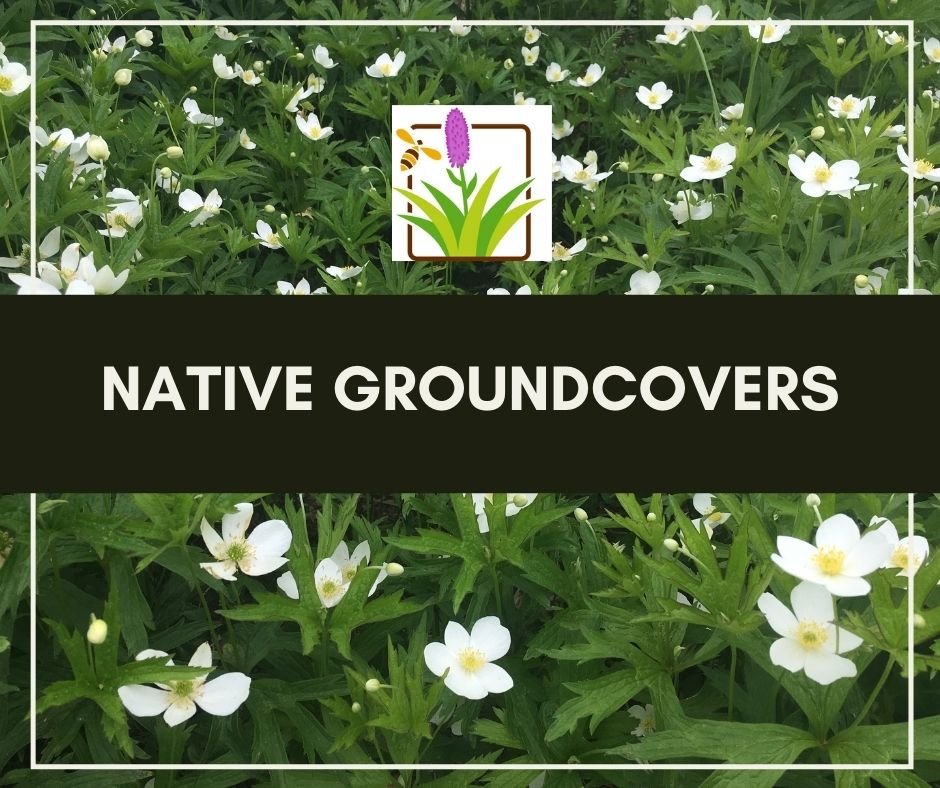Native Grasses for Ontario Gardens
| The ultimate guide to Ontarios’s most garden-worthy grasses |
Native grasses are crucial components of healthy gardens yet are often overlooked in favor of more showy flowers. In this article we will discuss the ecological and design benefits of using grasses in your garden and which ones are the best for landscaping. Click here to jump to the list of featured grasses.
The Benefits of Grasses in your Wildlife Garden
Host plants
In my opinion, the most over-looked benefit of growing native grasses in your wildlife garden is that they make great host plants! I notice that gardeners typically associate host plants with showy flowers such as Milkweed for Monarch butterflies or Pearly Everlasting for Painted Lady butterflies.
Just like these showy host plants, caterpillars and other insects have evolved special characteristics that allow them to eat the leaves of grasses.
For example, Bottlebrush Grass hosts caterpillars of the Northern Pearly Eye butterfly.
Little Bluestem hosts caterpillars of various Skipper species such as Indian Skippers and the Leonard’s skipper (Hesparia leonardus).
So, next time you are planning a butterfly garden, don’t forget the grasses - they are just as important as the flowers!
Natural bird feeders
Why buy bird seed when you can grow it? Most of our native birds eat seeds at one point or another in their lifecycle. Native grasses provide a bountiful source of seeds for birds. This is especially important over the fall and winter months when food is scarce.
Filling bird feeders can be an unpleasant and cold endeavor in the wintertime so why not supplement the wild birds’ diets with grass and enjoy watching them from the warmth of your house?
They key to feeding birds is to let your grasses stand over winter (no fall clean ups!) which leads into our next point…winter interest!
Winter garden interest
By leaving your grasses standing over winter, you will not only keep birds happy and healthy but you will create excellent winter interest in your garden. Many of Ontario’s native grasses will retain their structure well into the winter months.
The bronze colour of Little Bluestem contrasts against the snow and it’s fluffy seeds sparkle as they catch the low winter sun. The light beige colour of Switchgrass contrasts sharply with the darker brown seed heads of Hoary Vervain or Pale Purple Coneflower.
But winter interest should not be focused on the plants alone. You will also get to enjoy the presence of the birds who feast on the seeds.
Click here learn more about how to improve winter garden interest.
Reduce garden maintenance
Grasses and wildflowers are meant to grow together. Look around a natural prairie or meadow and won’t see one without the other. When we layer grasses and wildflowers together in the garden, we can create an interwoven matrix that resembles how these ecosystems are structured in the wild.
Mimicking natural ecosystems like this will help create a more resilient garden with reduced weed pressure.
Grasses also shade the ground in-between flowering perennials thus reducing evaporation and making your garden more resilient to drought. Many of our native grasses are very well adapted to dry conditions.
Wildlife Habitat
The layering of wildlflower’s and grasses, as mentioned above, also improves structure and diversity of your garden and therefore creates more opportunities for wildlife habitat creation. For example, tall grasses are an important part of fireflies habitat and you are more likely to see fireflies in areas with tall grass.
Despite being wind pollinated, grasses still support native bees. The exposed soil in between clumps of warm season grasses, such as Little Bluestem or Side-oats Grama, provides a perfect spot for ground nesting bees to make their homes. This is not possible in areas with mat-forming, cool season grasses such as those found in most hay fields.
Restoring Rare Ecosystems
A tallgrass prairie restoration with Indian Grass, Big Bluestem and Switchgrass
Native grasses are important for all the reasons mentioned above, but the key ecological reason to plant them is that they are critical components in one of Ontario’s rarest ecosystems - the tallgrass prairie.
Chances are that most people don’t relate Ontario to tallgrass prairie. However, tallgrass prairie was once found in scattered patches across Southern Ontario from Sarnia to Peterborough, covering roughly 1000 km2! Over the last few hundred years of European settlement, the majority of Ontario’s prairies have been lost to habitat destruction, mainly caused by urbanization and agriculture.
Now, as little as 1% remains!
As we loose ecosystems like the tallgrass prairie, we lose the wildlife that have come to depend on them.
The most dominant grasses of Ontarios tallgrass prairie are:
Big Bluestem (Andropogon gerardii)
Indian grass (Sorghastrum nutans)
Little bluestem (Schizachyrium scoparium),
Switch grass (Panicum virgatum)
Canada wild rye (Elymus canadensis)
By growing these grasses, especially in areas where tallgrass prairie once existed, you can help fix broken links in the food chain as many wildlife species benefit from grasses.
Using Grasses in your Garden:
For design purposes, native grasses can be divided into two categories:
Cool Season grasses are those that grow most actively during the cool weather of spring and fall, and go dormant in hot weather. The best time to plant, or sow seeds of, cool season grasses is in spring or fall. Bottlebrush grass and Junegrass are examples of cool season grasses.
Warm season grasses grow most actively during warm weather from late spring to late summer. They stay lush and green during the hot, dry weather of summer (right about the same time as your lawn is taking on that ugly, brown look). The best time to plant, or sow seeds of, warm season grasses is in late spring/early summer as the soil temperatures start to warm up. Most prairie species are warm-season including Little Bluestem and Indian Grass.
Typically, warm season grasses are the best choice for gardens as they are usually clump-forming and play very well with other plants. Non-clumping grasses that spread quickly by rhizomes can easily dominate your garden. A good example of this is non-native quack grass.
The amount of grass in your garden is also important. When planning your garden, you generally want to aim for a ratio of roughly 50% grass to 50% forbs (wildflowers). A ratio of 40% grass to 60% forbs works too. These ratios will allow enough grass to act as an effective ground-cover layer in-between flowers, thus suppressing weeds.
Too many grasses and flowers will be outcompeted.
Having a mix of cool and warm season grasses will further increase biodiversity and weed suppression.
The Best Native Grasses for Ontario Gardens:
So, what grasses are native to Ontario? There are many more than what are listed here but the following have been chosen based on their ornamental qualities, ecological value and commercial availability.
Big Bluestem & Goldenrod
Big Bluestem (Andropogon gerardii)
Height: 2m, 7ft
Exposure: Sun
Habitat: Prairies, meadows
Overview
Big Bluestem is a majestic warm-season, clump-forming native grass that combines beauty, function, and ecological value. It reaches up to 8 feet in height and is a great choice for naturalistic and prairie-style gardens.
Appearance and Seasonal Interest
Big Bluestem features gracefully arching foliage that sports a blue-green colour over the summer months. In fall, the foliage turns to shades of red, bronze, and purple. Its distinctive turkey-foot-shaped seed heads stand tall and straight above its arching foliage to provide year-round visual interest and privacy screening, even in winter.
Growth and Care
Big Bluestem thrives in various soil types, from sandy to clay-rich, but does best in sunny locations with good drainage. It is highly drought-tolerant and low-maintenance, making it ideal for a variety of garden types. While it maintains a well-behaved clumping habit, it may spread via self-seeding. To control undesired spread, deadhead the seed heads before dispersal or plant your garden densely so no bare soil presents opportunities for the seeds to sprout. Note that in rich soils or without competition from neighboring plants, it may become floppy, so pairing it closely with other tall prairie plants is recommended.
Ecological Benefits
This grass is more than just ornamental; it’s a key player in supporting wildlife, providing shelter and nesting material for over 24 species of songbirds. The seed heads feed birds. Deep roots stabilize soil and prevent erosion even along road sides as it is salt tolerant. Host plant for numerous Skippers including the Arogos Skipper, Delaware Skipper, and Dusted Skipper
The graceful growth habit of Sweetgrass (Anthoxanthum hirtum)
Sweetgrass (Anthoxanthum hirtum)
Height: 90cm, 3ft
Exposure: Sun, part shade
Habitat: Marshes, wet meadows, rain gardens
Sweetgrass is valued for its cultural significance, ornamental beauty, and ecological value. It is a low-growing, cool season grass which emits a delightful vanilla-like fragrance from the leaves and flowers. Sweetgrass is sacred to the Indigenous people of North America who braid and burn it in cultural practices. It is also used for weaving baskets.
Appearance and Seasonal Interest
Sweetgrass features slender, arching leaves flow gracefully from its crown to add desirable texture to the garden. Airy flower spikes rise above the foliage in early summer, adding elegance to the garden. In the fall, its foliage turns attractive shades of yellow. Winter interest is minimal. The plant spreads quickly by rhizomes, especially in moist, rich soils, creating a lush, dense groundcover.
Growth and Care
Sweetgrass thrives in sunny, wet areas but adapts well to average moisture and light shade. It spreads by rhizomes and is an excellent choice for gardeners looking for a fast-spreading grass. It performs best in sunny, moist locations like rain gardens, stream banks, or other areas prone to erosion. While it tolerates a range of conditions, ensure ample space is given to accommodate its spreading rhizomes. Sweetgrass works well as a groundcover among taller or more aggressive perennials that won’t be outcompeted by it such as Joe-pye, Golden Alexanders and Canada Anemone.
Ecological Benefits
Sweetgrass spreads rapidly by rhizomes making it ideal for erosion control. The foliage is usually avoid by deer.
The arching stems and red flowers of Side-oats Grama (Bouteloua curtipendula)
Side-oats Grama (Bouteloua curtipendula)
Height: <90cm, 3ft
Exposure: Full sun. Tolerates light shade.
Habitat: Dry prairies, sandy hills, open woods, fields.
Side-oats Grama is a compact, warm-season clumping grass perfect for sunny, well-draining locations. Known for its resilience, it thrives in dry soils and tolerates a range of soil types, provided they drain well. Its understated elegance and small stature make it a standout choice for natural landscapes where a tough, low-growing grass is needed.
Appearance and Seasonal Interest
Side-oats Grama produces sprays of blue-green foliage during the growing season which take on hues of golden tan in the fall and winter months. In summer, Side-oats Grama produces arching stems adorned with tiny, red flowers that dangle along one side, swaying gracefully in the breeze. The oat-like seeds that follow persist through winter, adding subtle beauty to the garden during colder months. When planted en masse, this native grass creates striking drifts or a soft, textured matrix groundcover to replace wood mulch between wildflowers.
Growth and Care
This low-maintenance grass grows best when planted in late spring or early summer, although anytime of the year works. While it forms neat clumps, Side-oats Grama spreads slowly into larger clumps each year by rhizomes, making it ideal for formal plantings where a well-behaved plant is required. Its drought tolerance and preference for full sun ensure it thrives even in challenging conditions. Side-oats Grama does not like competition from taller, more aggressive plants as it is easily shaded out. Its lifespan may be reduced in rich soils.
Ecological Benefits
Side-oats Grama is a powerhouse for wildlife. Birds enjoy its seeds and often use its material for nesting, while several Skipper butterfly species use the foliage as a host plant. Its ability to provide food, shelter, and nesting materials makes it an essential addition to any pollinator or bird-friendly garden that suits its growth requirements.
It doesn’t compete well with taller plants so pair it with compatible plants such as Butterfly Milkweed, Little Bluestem or Foxglove Beardtongue.
Canada Rye (Elymus canadensis) in a woodland edge garden.
Canada Rye (Elymus canadensis)
Height: up to 1.5m, 5ft
Exposure: Sun to shade
Habitat: Open woods, prairies, meadows, stream banks
Canada Rye is a versatile and low-maintenance native grass that offers beauty, ecological value, and adaptability. Whether you’re starting a prairie restoration, enhancing a pollinator garden, or adding texture to a formal design, Canada Rye is an excellent choice for adding year-round interest and supporting wildlife. Its ecological benefits and ease of growth make it a favorite among gardeners and restorationists alike.
Appearance and Seasonal Interest
Canada Rye is a cool-season, clump-forming native grass with a strong upright form and medium height. It greens up early in the growing season which is desirable for extending seasonal interest. Its arching stems and showy, drooping seed heads bring visual and textural interest to the garden. Looks great when planted en masse, especially when the seed heads sway beautifully in the wind or are backlit by the sun.
Growth and Care
This adaptable grass thrives in well-drained soils and grows in full sun to part shade, tolerating a wide range of conditions, even nutrient poor soil. It is best planted in spring or fall and serves as an excellent nurse crop for prairie restorations, providing protection for slower-establishing plants. While it self-seeds readily, it is not aggressive, making it suitable for both naturalistic and formal garden settings. Ideal as part of a matrix groundcover to replace wood mulch. Plays well with others due to its clumping nature and compliment taller, warm-season native grasses such as Big Bluestem and Indian Grass. It will self-seed, but typically not aggressively.
Ecological Benefits
Canada Rye is a rockstar for wildlife. The seed heads are relished by birds and the foliage is a larval host for skippers and satyrs. A great nurse crop for prairie and meadow restoration.
Bottlebrush Grass (Elymus Hystrix) seed heads
Bottlebrush Grass (Elymus Hystrix)
Height: 90cm, 3ft
Exposure: Dappled shade to part shade
Habitat: Forests, open woods, rocky woods
Bottlebrush Grass is a cool-season, upright bunchgrass celebrated for its shade tolerance and structural elegance. Often found growing naturally in rocky areas and slopes along the Niagara Escarpment, this native grass thrives in challenging environments, including dry shade with organically rich soils. Its adaptability and striking seed heads make it a favorite for shade gardens and naturalistic plantings.
Appearance and Seasonal Interest
This grass offers dynamic visual interest throughout the year. The foliage greens up early in spring, providing an early burst of greenery, and transitions to rich shades of bronze, burgundy and maroon in the fall, enhancing seasonal interest. Its spiky, bottlebrush-like seed heads stand tall and add textural interest. The seed heads look stunning when backlit by sunlight - grow en masse for best effect.
Growth and Care
Bottlebrush Grass prefers partial to full shade but will tolerate some sun, especially in moist soil. It thrives in a variety of soil types, even clay, but does best in dry to moderately moist soils with good organic content. This low-maintenance grass is perfect for rocky areas, slopes, and shaded woodland edges. Use as an architectural plant to bring vertical interest to woodland gardens. It maintains a clumping form and spreads non-aggressively by seeds.
Companions for Bottlebrush grass include other forest floor species such as Ferns, Large-leaf Aster, Bluestem Goldenrod or Wild Ginger.
Ecological Benefits
Bottlebrush Grass hosts caterpillars of the Northern Pearly Eye butterfly. The seeds provide food for birds during the fall months.
Virginia Rye (Elymus virginicus)
Virginia Rye (Elymus virginicus)
Height: 1.2m, 4ft
Exposure: sun to part shade
Habitat: Wetlands, bottomland forests, stream banks
Virginia Rye is a cool-season bunchgrass that shares similarities with Canada Rye but thrives in moister habitats and prefers fertile soils. Known for its striking seed heads and ease of growth, this native grass is perfect for adding structure and seasonal interest to a variety of landscapes, particularly in moist areas such as rain gardens or wetlands.
Appearance and Seasonal Interest
Virginia Rye greens up in early spring, growing best in the cool weather, where it shoots up with an upright form and medium stature. The graceful, sword-like leaves lend a desirable texture to the garden. Seed heads rise through the foliage, standing tall and strong through the winter months to extend seasonal interest. In dry soils the leaves may go dormant during the heat of summer but will return with vigor once the cooler fall temperatures return. Can be used in natural or formal gardens alike.
Growth and Care
This grass is easily grown from seed and can be sown or planted in early spring or fall. It thrives in fertile, moist soils and is best planted in as a matrix groundcover plant to replace wood mulch. Virginia Rye works well in areas with consistent moisture, making it ideal for rain gardens, stream banks, or shaded woodland edges. To avoid a floppy growth habit, it is best grown in dense plantings with compatible species such as Canada Anemone, Blue Vervain, Joe-pye and Turtlehead. It retains a clumping habit but may self-seed occasionally in bare soil.
Ecological Benefits
Virginia Rye serves as a larval host for Skipper and Satyr butterfly species. The seeds are an important food source for birds during the winter months. The foliage makes great cover for songbirds and small mammals.
Junegrass (Koeleria macrentha)
Junegrass (Koeleria macrantha)
Height: < 90cm, 3ft
Exposure: Sun
Habitat: Prairies, hillsides, sand dunes, open woods
Junegrass is a cool-season, clumping grass prized for its early spring growth, resilience in dry, infertile soils and its showy seed heads. Naturally found in dry, sandy areas, it adapts well to a range of well-drained soils, including compacted soils, making it an excellent choice for ecological restoration projects. Its ability to thrive in challenging conditions and its striking seasonal appeal make it a key component in natural garden designs in Ontario.
Appearance and Seasonal Interest
Junegrass greens up early in the spring, providing a refreshing contrast to the surrounding brown landscape. Its attractive blue-green foliage offers early-season greenery and a strong vertical presence, despite its small stature. In early summer, the golden-brown seed heads provide visual contrast to surrounding warm-season grasses, like Little Bluestem, and other early summer flowering perennials. The delicate seed heads hold their own in the garden, offering texture and movement, and they are a food source for birds during the fall and winter months. It makes an excellent structural plant for shorter plantings.
Growth and Care
This versatile grass thrives in well-drained, dry soils but is adaptable to a variety of soil types. It can even grow in compacted soils. Junegrass prefers full sun but tolerates light shade, and it does best when planted in well-drained areas where it can establish deep roots. It is a very well-behaved grass, maintaining a clumping form and only self-seeding in exposed soils. Pair it with plants of similar height because it does not tolerate competition very well. Companion plants for Junegrass include Prairie Smoke, Nodding Onion, Wild Lupin, Butterfly Milkweed or warm-season grasses like Little Bluestem.
Ecological Benefits
The seeds of Junegrass are consumed by birds, adding value to wildlife-friendly gardens. Its deep roots help stabilize soil and prevent erosion.
Switch Grass (Panicum virgatum) has a tall, upright stature.
Switch Grass (Panicum virgatum)
Height: 1.8m, 6ft
Exposure: Sun - light shade
Habitat: Prairies, meadows, open woods, shorelines
Switchgrass is a tall, warm-season bunchgrass that is a defining feature of Ontario’s tallgrass prairie. Known for its elegant vertical stature and adaptability, it deserves to be a defining feature in your garden too! It grows big and tall but is not an aggressive spreader. Its beauty, particularly in winter, makes it a standout addition to natural gardens, prairie landscapes, and meadow plantings.
Appearance and Seasonal Interest
Switchgrass is celebrated for adding height and privacy to gardens with its graceful, arching foliage. In mid-summer, it is topped with airy, pink-green flower clusters that add a light, airy effect to the garden. These flowers mature into tan seed heads that persist through the winter to offer visual interest and texture when it is needed most. The foliage transitions to a rich beige color in the fall, providing a stunning contrast against the seed heads of wildflowers and other grasses adding a whole new layer of beauty to the senescence of fall. Best planted as an architectural plant and en masse.
Growth and Care
Switchgrass is adaptable and can thrive in a wide variety of soil types and moisture regimes, even heavy clay or sand. While it grows best in medium to moist soils, it can tolerate dry conditions, though it will remain shorter in such environments. It requires full sun for optimal growth, where it reaches its mature height, which can range from 3 to 6 feet, depending on growing conditions. It may go floppy in rich soils and without competition from surrounding plants. Its slow spread by rhizomes makes it suitable for more controlled landscapes while still offering naturalistic movement in the garden. Self-seeds non-aggressively in most situations. Pair Switch Grass with Woodland Sunflower, Giant Purple Hyssop, Smooth Aster or even Pale Purple Coneflower.
Ecological Benefits
The seeds are an excellent food source for birds while the foliage provides excellent cover and nesting sites year-round. Host plant for several skipper species including the Delaware Skipper (Anatrytone logan), Arogos Skipper (Atrytone arogos), and the Dakota skipper (Hesperia dacotae)
The fluffy seed heads of Little Bluestem (Schizachyrium scoparium)
Little Bluestem (Schizachyrium scoparium)
Height: 90cm, 3ft
Exposure: Sun
Habitat: Shortgrass/tallgrass prairies, sandy shores, alvars
Little Bluestem is a warm-season, clumping grass that has solidified its place in native plant gardens for good reasons. It is known for its stunning blue-green foliage, exceptional drought tolerance, well-behaved growth and winter interest.
Appearance and Seasonal Interest
Little Bluestem is valued for its striking foliage, which begins the growing season as blue-green and transitions to a vibrant bronze and copper hues in the fall. Its fluffy seed heads add texture and softness to the garden in late summer and fall, looking their best when backlight by the late afternoon sun. The plant’s upright form holds its structure throughout the growing season, and in winter, its dried seed heads and foliage remain visually appealing, providing year-round interest—especially when planted in mass.
Growth and Care
Little Bluestem thrives in dry to medium, well-drained soils and can tolerate a wide variety of soil types. While it flourishes in full sun, it may become floppy in rich soils or too much shade. An excellent choice for xeriscaping or low-water gardens. It thrives in full sun and will stay green during the toughest droughts. It is well-suited to poor soils and requires little maintenance once established. It maintains a well-behaved clumping form and spreads lightly by self-seeding, making it ideal for small or formal gardens. Companions for Little Bluestem are numerous. In really dry soils, try pairing it with Butterfly Milkweed, Slender Blazing Star and Nodding Onion.
Ecological Benefits
The foliage of Little Bluestem feeds a variety of Skipper species. The dried leaves are popular nesting materials for birds. The seeds are eaten by birds.
The Blue-gray foliage of Indian Grass (Sorghastrum nutans)
Indian Grass (Sorghastrum nutans)
Height: 2m, 7ft
Exposure: Sun
Habitat: Prairies, meadows, open woods, fields
Indian Grass, also known as Savanna Grass, is a warm-season, clumping grass that is a defining species of the tallgrass prairie. It is highly valued for its striking blue-gray foliage, impressive vertical stature, and adaptability to a wide range of well-draining soils. It is a fantastic choice for naturalistic gardens, formal gardens, prairie restorations, and any other wildlife-friendly landscape, offering the ideal blend of both aesthetic appeal and ecological benefits.
Appearance and Seasonal Interest
Indian Grass is known for its tall, elegant form, reaching heights of 4 to 6 feet, which makes it an excellent choice for privacy screens, hedges, or as a backdrop in gardens. This grass features blue-gray foliage that creates a soft, cool effect in the landscape, transitioning to a stunning bronze/orange hue in fall. The vibrant color in autumn is accompanied by showy seed heads, which add texture and interest to the garden through winter months. Best used in large clumps as an architectural plant or feature.
Growth and Care
Indian Grass thrives in dry to average soils but is fairly adaptable to a range of well-draining conditions, even tough clay. It prefers full sun and is well-suited to areas where soil is not overly rich or moist. In drier soils, it will remain shorter, but it is still a robust, durable grass that can withstand periods of drought once established. Indian Grass is a clumping grass that spreads slowly via self-seeding, offering a neat and organized form without becoming too aggressive in the garden. To prevent it from flopping, pair it with other tall, compatible prairie species such as Big Bluestem, Oxeye Sunflower, New England Aster or Wild Bergamot.
Ecological Benefits
Indian Grass provides habitat and food for wildlife. The foliage supports the larvae of various Skipper species, while its seeds are eaten by birds in the fall and winter. The dried leaves and stems are often used by birds for nesting material, providing shelter and food sources for small creatures. The persistent foliage of Indian Grass creates a shelter for wildlife through the winter months, making it an excellent plant for gardeners looking to support local fauna year-round. Like many prairie grasses, Indian Grass helps stabilize soil with its deep roots, preventing erosion and improving soil health.
The airy seed heads of Prairie Dropseed (Sporobolus heterolepis)
Prairie Dropseed (Sporobolus heterolepis)
Height: 60cm, 2ft
Exposure: Sun
Habitat: Prairies
Prairie Dropseed is a warm-season, clumping grass that is highly valued for its delicate, mounding form and airy sprays of seed heads. Native to North America’s prairies, it is well-suited to dry to average soils and thrives in full sun. It is well-known for its remarkable drought tolerance, thriving in hot and dry conditions where many other plants wont. It is particularly well-suited for urban gardens or formal gardens where self-seeding is not desired due to its slow growth habit and low propensity for reseeding.
Appearance and Seasonal Interest
Prairie Dropseed has an elegant, fine-textured appearance with sprays of soft, arching foliage that gently sway in the breeze. Its bright green foliage is particularly eye-catching in the spring and summer which is when it grows best. As the season progresses into fall, the plant develops its elegant seed heads which take on a golden-bronze hue, creating a warm presence in the garden. The seed heads persist into winter where the golden-bronze color contrasts beautifully against the surrounding garden, especially when the light catches the seed heads.
Growth and Care
Prairie Dropseed thrives in dry to average soils and requires full sun to perform at its best. It is highly drought-tolerant and well-suited for dry, low-maintenance gardens, boulevard gardens or xeriscaping projects. This grass needs well-drained soils. In rich soils it may suffer from shortened lifespan or floppy growth. Prairie Dropseed is slow-growing and does not tend to self-seed prolifically, making it an ideal choice for urban gardens where a neat, controlled appearance is desired. Prairie Dropseed doesn’t like competition from taller, more aggressive species. Try pairing it with native prairie species like Butterfly Milkweed, New England Aster or Pale Coneflower.
Ecological Benefits
Prairie Dropseed provides important habitat and food for wildlife. The seeds are eaten by birds, and the plant itself is a host for Skipper butterfly larvae.
Poverty Oat Grass (Danthonia spicata)
Height: 60cm, 2ft
Exposure: Sun, part sun
Habitat: Dry, upland woods; limestone bluffs; rocky or sandy slopes.
Poverty Oat Grass is a cool-season, clump-forming grass that has yet to gain widespread popularity in native plant nurseries and gardens, but it has a lot to offer! It is a highly adaptable, drought-tolerant grass that thrives in nutrient-poor, gravelly soils, making it an excellent choice for low-maintenance landscapes, rock gardens, and erosion control projects. Its compact form makes it ideal for tight spaces or smaller gardens.
Appearance and Seasonal Interest
This grass features dense, tufted foliage that greens up early in the spring, providing a burst of green in the garden before many other plants emerge. The foliage has a fine texture and a slightly blue-green hue. As the season progresses, the foliage takes on a more wiry, twisted appearance, adding interesting texture to the garden. In fall and winter, the dried leaves form twisted clumps that bring movement and visual interest to the garden, especially when backlit by the sun.
Growth and Care
Poverty Oat Grass thrives in dry, nutrient-poor soils, particularly in gravelly or rocky areas. It is highly drought-tolerant, making it a great option for dry landscapes or areas with poor soil fertility. This grass grows best in full sun and requires minimal care once established. It forms a dense, non-aggressive root system that helps mitigate erosion, making it valuable for slopes, hillsides, or areas prone to soil erosion. Best used as a matrix groundcover plant to replace wood mulch. Despite its toughness, it does not spread aggressively, so it remains well-behaved in garden settings. Note that it does not like being shaded by taller plants, so pair it with wildflowers like prairie smoke, Harebells, Upland White Goldenrod or Cutleaf Anemone.
Ecological Benefits
The leaves of Poverty Oat Grass serve as a host for caterpillars of the Leonard’s skipper and Indian skipper butterflies. It also supports a range of insects beneficial to the garden ecosystem. Unlike many other grasses, Poverty Oat Grass is not highly favored by deer or rabbits, making it a good choice for gardens that experience heavy browsing pressure.
